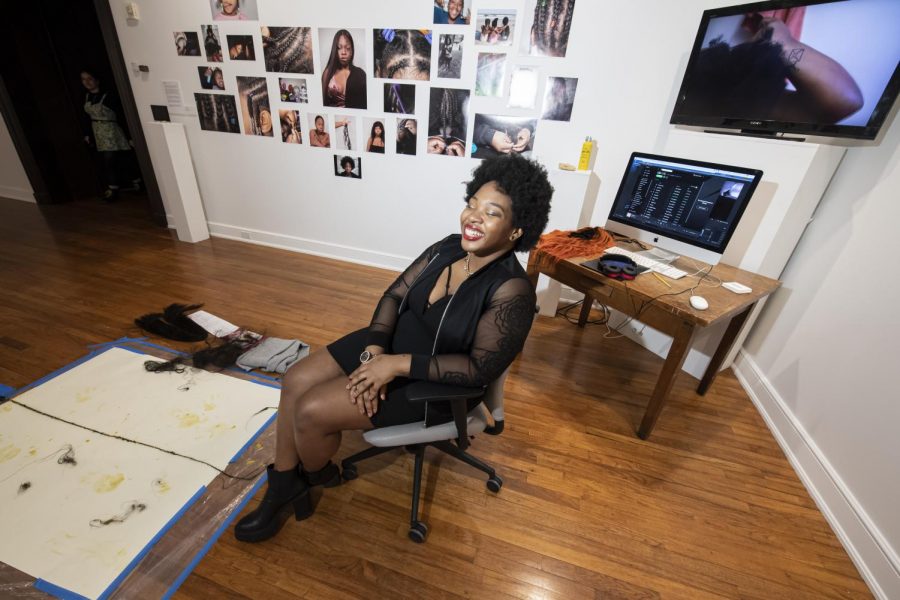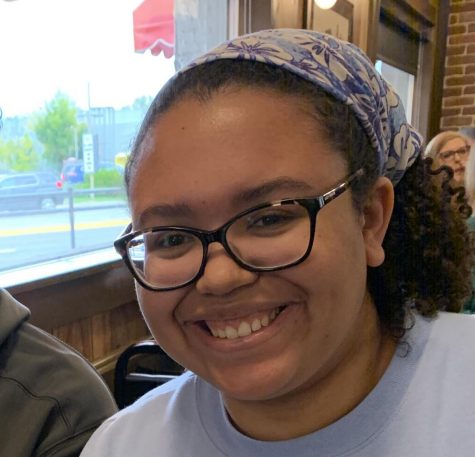‘Roots Run Deep’ celebrates Black hair, features student artist’s work
Photo courtesy of Brianna Mims
Brianna Mims will have two photographs from a larger series she worked on between 2018 and 2020 focused on natural hair on display as part of Brewhouse Gallery’s new exhibit “Roots Run Deep: A Contemporary Survey of African American Hair Culture.”
January 29, 2021
Brianna Mims used the basement of the Frick Fine Arts Building throughout 2018 and 2019 to create art pieces focused around hair and her experiences with it. Some of those pieces are on display now, over two years later, alongside the work of several other artists celebrating Black hair.
Mims, a senior psychology and studio arts major, contributed to the new exhibit “Roots Run Deep: A Contemporary Survey of African American Hair Culture” at the Brew House Gallery in the South Side. The exhibit opened last Friday and will run until March 6, with the gallery open to the public during select times on Thursdays, Fridays and Saturdays.
The exhibit will feature work by Mims and 15 other Black artists, stylists and cultural producers. It includes photographs, mixed media pieces and sculptures that look at historic influences on modern styling techniques, and the way Black hair is tied to tradition. Tara Fay Coleman, the exhibit’s curator, worked with Natalie Sweet, the program director of Brew House, to put the exhibit together.
“The process involved sourcing work that already fit within the framework of what I was trying to put together,” Coleman said, “and finding artists who I wanted to work with who could make work specifically for this exhibition. The goal was to tell a story.”
Coleman said she took inspiration from other works and exhibitions about Black hair, and wanted to do something similar that highlighted artists from Pittsburgh.
“I was inspired a lot by Sunday School’s Hair Appointment exhibition, and I wanted to create something similar, but with a large local component. I wanted to recognize a lot of Pittsburgh’s hair artists and shops,” Coleman said. “I was also really inspired by Spike Lee’s School Daze.”
Mims will have two photographs on display from a larger series she worked on between 2018 and 2020 focused on natural hair. In some cases she used her own hair, in others she used wigs.
“They are images that depict different aspects of Black female hair culture,” Mims said. “I kinda was just going for a more simple contemporary photography kind of look, but taking domesticated and Black beauty culture objects and my own hair to sort of make this image that’s very simple, but it’s also saying a lot in a little bit of space.”
According to Yasmine Crawley — a Pitt senior and president of Crown Culture, a club that celebrates natural hair — the term “natural hair” refers to hair textures and styles commonly found amongst people of the African diaspora.
“I would say braids, having your regular curls out from a wash and go, an Afro,” Crawley said. “A twist is another popular one, or even just twists with extensions, braids with extensions. Those are some pretty popular natural hairstyles.”
Crawley said the stigma surrounding natural hair has been an issue for Black activists for decades, since natural hairstyles like curls and dreads can be considered “unprofessional.”
“I would say previously, it’s definitely been shamed upon and has carried a negative connotation especially with Black women,” Crawley said. “We have a very complex relationship with our hair, so while we want to take pride in it, it’s hard to do that when society and the media is constantly telling you that it’s unattractive or that it is unprofessional.”
Coleman said she decided to center the exhibit around natural hair because of how it factors into everyday life for Black people.
“It relates to the Black experience, and it’s important for those experiences to be talked about and shared with audiences who can understand and relate to them,” Coleman said. “I want to not only redefine what qualifies as fine art, but also shift how it’s viewed, which is, historically through the lens of whiteness.”
Mims said while working on her pieces, she grew to appreciate her own hair more.
“I don’t know what it was but it just got me to a place where I found acceptance from my appearance,” Mims said. “It wasn’t like that was the initial goal when I started the work, but it was like I had to be consuming Black female content and creating Black female content. When I started I had no idea what that was.”
Mims’ works in “Roots Run Deep” were originally part of a student art show at the Fricks Fine Arts Building, and then part of the Black To The Future event held by the Center for African American Poetry and Poetics in 2020. Coleman asked Mims at that show if she could use her artwork in an upcoming exhibit.
“Brianna’s work immediately spoke to me, and I knew as soon as I saw it that I wanted to include it,” Colemain said. “It fit in the exhibition so well, and it was even more meaningful because it represented very personal experiences for her.”
Mims said appreciates that the show allowed her to work with other Black artists, and hopes her work will resonate with other Black people.
“I’m really excited to be a part of this show because this is actually the first time that my work will be in one show that is curated by and for Black people,” Mims said. “That’s an opportunity that I haven’t had working through Pitt.”
A previous version of this article identified Tara Fey Coleman as the curator of “Roots Run Deep.” The curator’s name is Tara Fay Coleman. The article has been updated to reflect this change. The Pitt News regrets this error.









